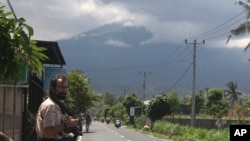When an enormous volcano belches ash and the people who live around it flee, you get out too, right? Probably. But apparently not always.
The compelling impulse to see an aggressive and majestic show of nature, and to record an uncontrollable force, is motivating some visitors to the tropical island of Bali to stick around for a while rather than just head for the nearest airport.
Take Mark Levitin. He's not going anywhere. The activity inside Mount Agung is the 12th volcanic eruption he's witnessed up close.
"It's just beautiful. I like the power of them," said the lanky 39-year-old, who grew up in Russia and Israel.
"We're living on what is essentially a huge bowl of magma with a very thin crust," Levitin said. "Even the place we call home is mostly hot enough to vaporize us in an instant."
Many foreigners are making haste to leave the idyllic Indonesian island after its airport, shut for 2 days due to drifting ash, reopened on Wednesday afternoon, providing what could prove to be a brief window to depart by air for tens of thousands who were stranded.
Some airlines are advising people who'd already booked travel to Bali that they can cancel, defer or change their destination because the airport could easily be forced to close again by a bigger eruption or by the billowing columns of ash moving back in its direction. Its last major eruptions, in 1963, killed about 1,100 people and the volcano didn't quiet down for a year.
But leaving is not the agenda for Mariano Gonzales, a polyglot travel guide from the Canary Islands, who to his surprise was turned away from an ash-covered hotel he arrived at three days into his two-week Bali vacation.
"I was a little bit shocked because everybody was a little bit stressy because they saw me arriving with my bags and I didn't know anything about this volcano," said Gonzales, who is now staying in Amed, a picturesque fishing village with a spectacular view of the smoking volcano about 15 kilometers (9 miles) away.
He said he tried to get closer to the mountain but was turned back at a checkpoint.
"We feel comfortable. We're enjoying our beer and this beautiful view," said Gonzales, sitting cliff side at the Sunset Point bar that has a panorama of the cone-shaped mountain, the Bali sea and rows of brightly painted fishing boats below.
"We are not scared about it. It's a nature thing. If it has to happen it will happen so nobody will stop it," he said.
Indonesian disaster officials ordered 100,000 people to leave the exclusion zone that in places extends 10 kilometers from the crater after the mountain began violently erupting on Saturday.
Since then it has gushed ash almost continuously, hurling the gray-back columns of dust, steam and smoke 4,000 meters (13,200 feet) high and glowing a menacing red at night as lava wells up inside. Lahars of muddy volcanic debris have flowed down its sides through some villages.
Though many Balinese did heed the officials and leave the immediate danger zone, some feel they have no choice but to keep farming their lands in the volcano's shadow.
Katut Wiri and her family were planting crops Thursday in an area that authorities warn would be in the path of hot ash clouds and mudflows during a major eruption.
"If I'm not planting these fields, somebody might come and claim it and start farming on it. So I won't have any land to farm," said the mother of three. "So that's why I came and started planting."
Two light brown Bali cows dragged a rustic plough that turned over the dark soil made fertile by other eruptions decades and centuries ago. Wiri and her mother-in-law poked the tilled dirt with sticks and expertly aimed seeds at the small holes while smoothing the earth over the incipient crop with their feet.
"Yes I'm afraid. I feel really nervous. My heart pounds. Seeing the condition of the volcano frightened me," said Wiri.
Levitin, who said volcanos are a sideline to his main interest of photographing shamanic rituals, believes the Amed area, though close to the volcano, is protected by its geographic features such as ridges.
"My first volcano was almost 20 years ago in Costa Rica. Almost killed me," he said. "I had no experience and didn't know how to do it and I almost walked right into a bombardment of volcanic rocks."
But, he adds, in the unlikely event an eruption is huge beyond any expectations, nowhere on Bali would be safe.
"If you see a hot cloud coming toward you the best thing you can do is start praying because it's basically too late to do anything else."









